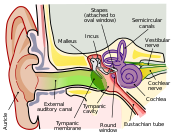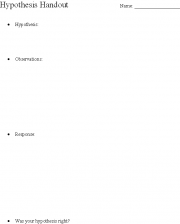Water Organ
| Instant wiki maker | Making handouts | Editing tips |
Contents
- 1 Student worthiness
- 2 Primary biological content area covered
- 3 Materials
- 4 Handouts
- 5 Word bank
- 6 Description of activity
- 7 Lesson plan
- 8 Potential pitfalls
- 9 Math connections
- 10 Literature connections
- 11 Art connections
- 12 Connections to educational standards
- 13 Next steps
- 14 Reflections
- 15 Citations and links
Biology In Elementary Schools is a Saint Michael's College student project from a course that ran between 2007 and 2010 and fully described in this book chapter. The student-created resources have been preserved here for posterity. Link under 'toolbox' for printer-friendly versions of the exercises. Click on handouts to print full resolution versions. Please see Wikieducator's disclaimer, our safety statement, and the Creative Commons licensing in English and in legalese.
Student worthiness
This experiment is tried and trusted.
Primary biological content area covered
During this activity the students will be learning about sound waves and frequencies while using their senses.
- Water Glasses and Tuning Forks
Materials
- wine/water glasses with stems
- water
- tape (to tape the glasses to the table so that they don't move during the experiment)
- beakers
- tuning forks
Handouts
Word bank
Five Senses include touch, taste, hearing, smell, and taste.
Hearing is the sense of sound perception.
The Ear drum is a thin membrane that vibrates when sound waves reach it causing a person to hear.
The nerves transmit the sound waves that have been converted into electric impulses to the brain, which translates the electrical impulses into the sound that a person hears.
Sound waves are created when an object vibrates and causes the air particles around it to vibrate. When the particles vibrate they bump into each other causing more particles to vibrate. This bumping of the air particles is what makes the sound wave and the wave continues until the wave runs out of energy.
Frequency is the number of occurrences of a repeating event per unit time.
Description of activity
Students will explore the effects of sound frequency. The students will create their own water organ that will have a variety of sounds. They will then be expected to create a hypothesis as to what will happen when they run their fingers around the glass. They will also have the opportunity to add or remove water to make a wider variety of sound. Students will record both their hypothesis and their observations. The second way that students will explore sound frequency is through tuning forks. They will be able to test the distance between their ear and fork. Again students will be able to record both their hypothesis and their observations.
Lesson plan
We first started the lesson by introducing the activity. As a group we talked about sound frequencies and how they worked. From there we told the students what we wanted to do as an experiment. We explained that we were going to be measuring water into glass wine glasses and that we would be using our fingers to circle around the top of the glass to try and create a frequency. We also asked students to create a hypothesis about what they thought was going to happen with the glasses in relation to sound.
From there we asked the students to measure out water for the wine glasses so that they would be able to test out the experiment. The students were each given a beaker to fill with water, and then asked to fill the wine glass with the water that they measured out. After the students finished filling their glasses we asked them to try out making music with the glasses. After several tries the students were able to get the hang of it and were able to create noise with their glasses.
After the students finished testing out the experiment we started to explain to them what sound waves and frequencies are. We demonstrated how different sound waves have different frequencies by using the tuning forks. First we hit the tuning forks on our knees, and demonstrated how the different forks had to be held at different distances from the ear in order to hear the sound. This demonstrated the length of sound waves and the different frequencies of the sound waves. From there we showed the students how we can tune the note that the wine glass plays by using the tuning fork. We did this by adding or removing water with a dropper until we were able to hit the tuning fork and hold it over the glass and the students were able to hear the note without running their fingers along the top of the glass.
We allowed the children to then play around with the wine glasses making music of their own choice. After allowing them some free time with the "water organs" they were asked to complete a handout regarding whether their hypothesis was correct and to reflect on what they had learned.
Potential pitfalls
A potential pitfall of this experiment is that it may take a minute to get the glasses working and making a sound. There is also the danger of breaking a glass, so students and teachers should be very careful with the glassware.
Math connections
The students will be asked to measure the amount of water that goes into the wine glasses. They will then record the measurement on a graph. Once they have recorded their measurement they will test the water glass for high or low frequency. The end graph should be a relation between the amount of water and the frequency in the glass. (since it is hard to find the exact measurement for frequency that part of the graph can simply be based on high or low or somewhere in the middle scale).
Literature connections
The literature connection to this unit is The Magic School Bus Explores the Senses by Joanna Cole & Bruce Degen. This book does not deal directly with sound waves; it does however talk about how the ear interprets sound, so if that's a route you want to take this book would be PREFECT!
Another good Magic School Bus book is The Magic School Bus in the Haunted Museum: A Book About Sound.This book would be more appropriate lesson for sound waves [1].
Art connections
The art connection in this activity is the sounds that the students will be producing. They will be using these sounds to create music and songs.
Connections to educational standards
This activity meets the educational standards of Vermont in a few different ways:
- Students will apply the scientific method: they will be asked to formulate a hypothesis, they will then test it and record the results.
- Students will also be investigating. They will be allowed to play with the water glasses and make their own ideas about what is happening in the activity.
- They will be asked to record their results, so their data will be collected in ways that others can verify.
- A final educational standard that will be met is the concept of a theory. The students will realize that the glasses with more water will make a lower tone and a theory can be discussed as to why this is happening.
Next steps
In this lesson the main focus was put on sound. The students we taught about sound waves and frequencies, while also unknowingly learning about the distances that sound travel by using the tuning forks. However, there are different avenues that one could take to try and expand on this experiment. The students could explore more with sound by making other instruments that allow the students to hear more of a variety of frequencies. (See Good Vibrations for a great lesson involving other homemade instruments!). Students could also learn about the anatomy of a human ear. Exploring how the ear works and the different parts of an ear would allow students to have a better understanding of how and why they can hear sound waves.
Reflections
Overall the lesson went GREAT! The water glasses worked very well and no one had trouble making sound with them. The tuning forks didn't work well in relation to the glasses but they were a fun add on that helped the students talk about sound. When the students first came into the lesson some of them knew some things about sound. For instance some of them knew that sound is caused by vibrations. Other students didn't really know anything except that we hear sound with our ears. However based on their knowledge we were able to bring in an example of sound in relation to water to help them connect to the lesson. We were able to ask students what happens when you drop a stone into Lake Champlain? What kind of sounds do you hear? What do you see happening? These questions were definitely a must do component of the lesson. Another must do component is that students have to listen to the other sounds from all the glasses and experiment with how the water level changes the sound. It would have been great if the tuning forks worked but without them the lesson was still good.
Citations and links
1. http://www.scholastic.com/magicschoolbus
2. http://www.sciencenewsforkids.org/articles/20081015/Feature1.asp
3. http://www.enchantedlearning.com/subjects/anatomy/ear/label/labelanswers.shtml
Vermont Standards and Grade Expectations
http://www.audigygroup.com/info/mechanics.html
http://www.sciencekidsathome.com/science_topics/what_is_sound.html





